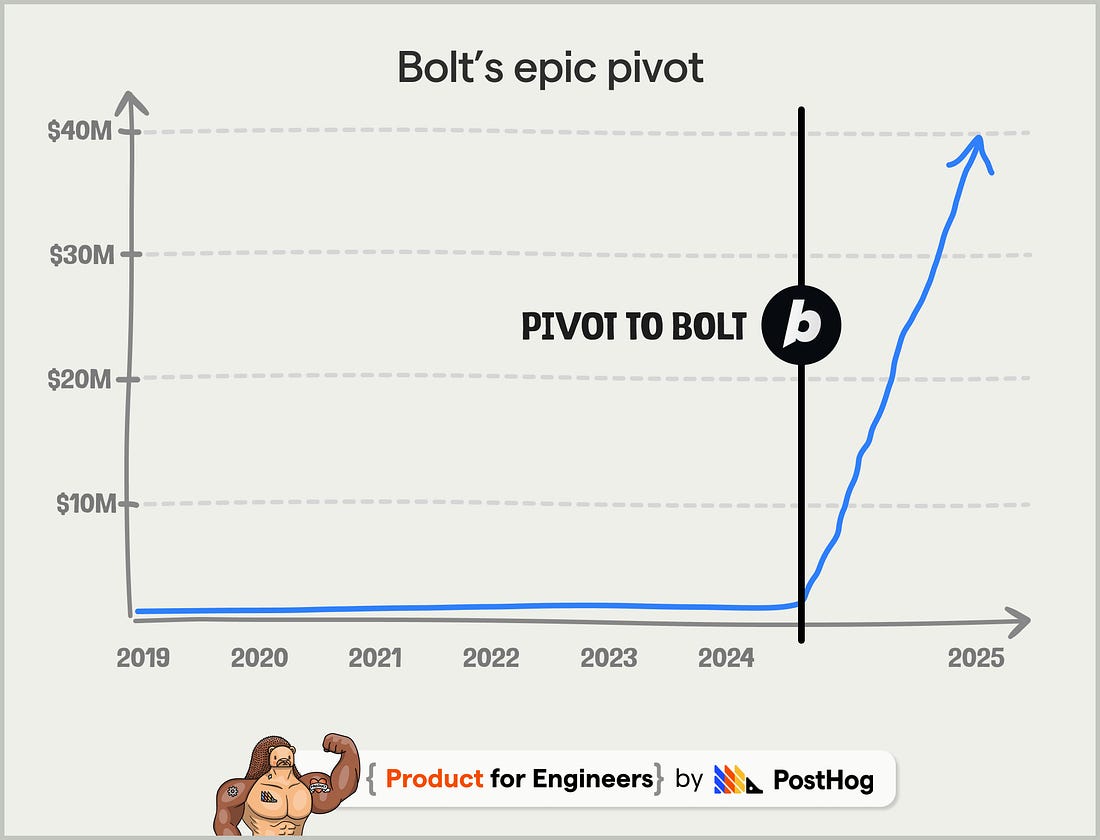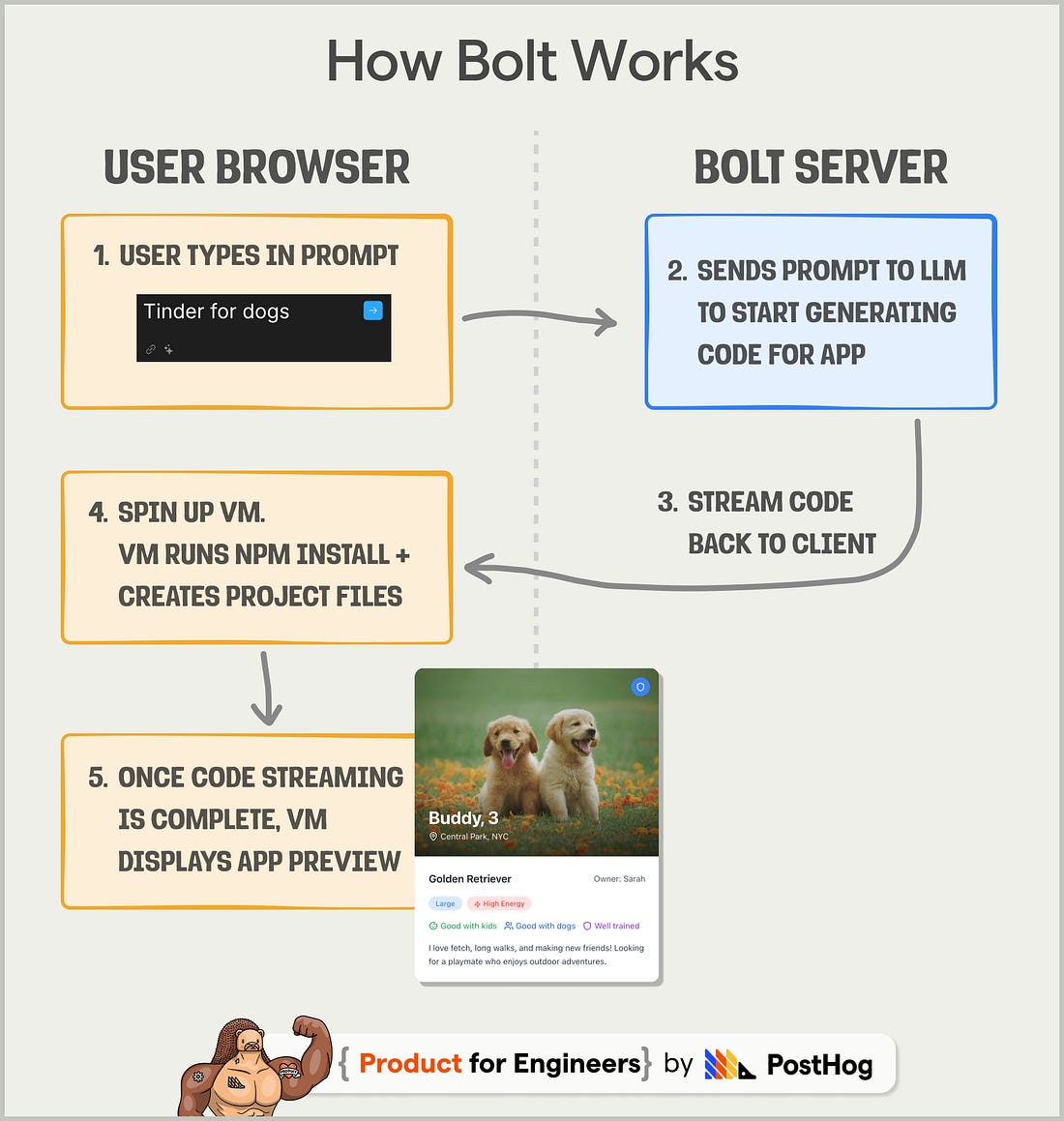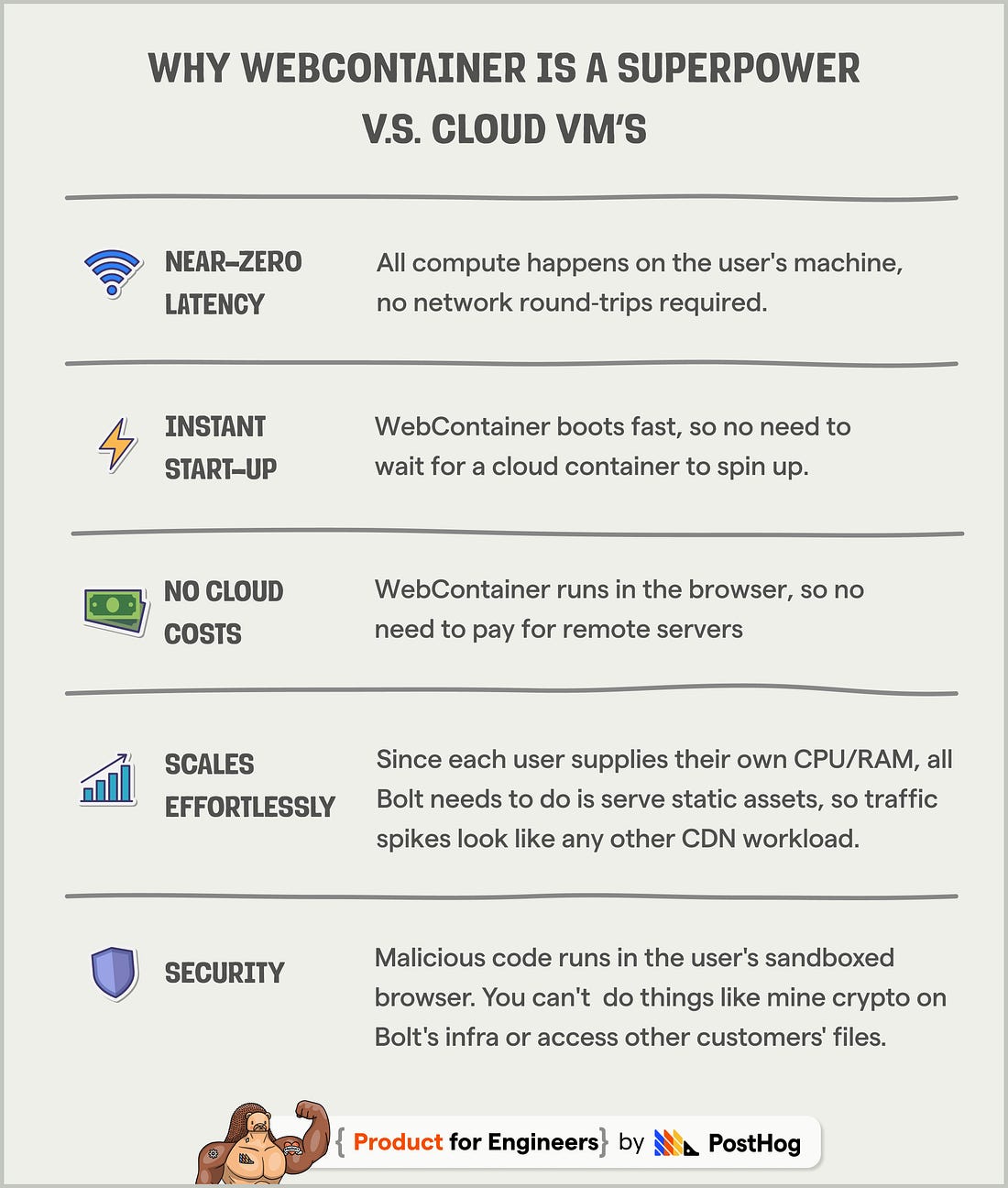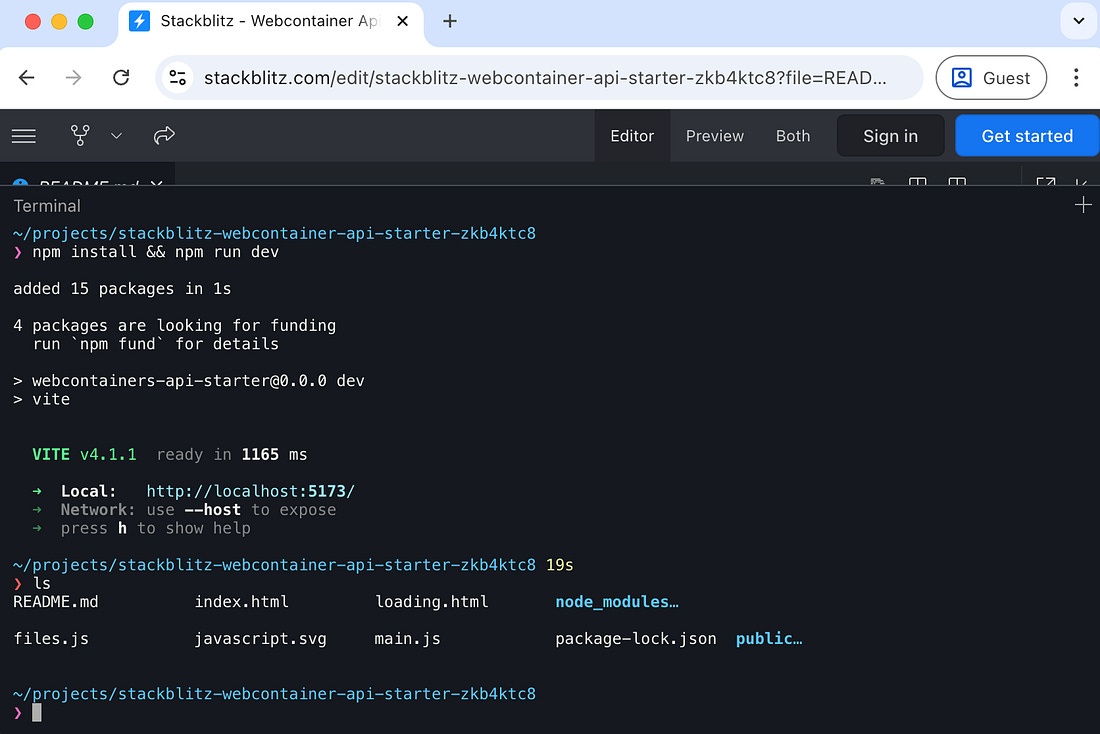From $0 to $40M ARR: Inside the tech that powers Bolt.new
If you've started a new side-project recently, there's a good chance you've bumped into Bolt – a one‑prompt app builder that went viral thanks to demos that look like magic. Type a sentence, wait a few seconds, and out pops a fully running project. From the outside, Bolt seems like an overnight success story – another startup riding the wave of the AI boom. In fact, Bolt is among the most successful startup pivots ever. An overnight success that was seven years in the making. This graph speaks for itself. Since that pivot in October 2024, Bolt’s users have created millions of apps, and Bolt is generating $40 million in ARR with an engineering team of just 15. A truly epic turnaround. I spoke with co‑founder and CTO Albert Pai, and founding engineer Dominic Elm, to understand how Bolt puts the rabbit into the hat. How Bolt worksTo understand some of the technical challenges of building Bolt, let's see what happens after entering a prompt:
What's fascinating to me is how simple it all is. I thought Bolt would be orchestrating a whole chain of LLM calls and fine‑tuned models, but in reality the entire app springs from a single, meticulously crafted prompt. The real story here is WebContainer, Bolt's in‑browser VM. As Albert Pai, Bolt’s founder and CTO, notes: “People assume we’re running a giant server farm. In reality, the server is your browser.” Before pivoting to building Bolt, the team spent seven years building StackBlitz, a browser‑based IDE. StackBlitz's core tech was WebContainer, an open-source runtime they built that boots up Node.js entirely in a browser. Despite millions of developer sessions, StackBlitz was on the brink of shutting down. Then, in mid‑2024, the latest wave of LLMs proved that AI could build high quality apps end-to-end. Recognizing that WebContainer was the perfect runtime for this new workflow, they pivoted and relaunched as Bolt in October 2024. In only 30 days they rocketed from $0 to $4M ARR, and six months later they 10x'ed to $40M. WebContainer is Bolt’s superpower. Most AI app builders spin up a fresh container in the cloud for every session, which adds cold starts, network round-trips, and per-user costs. WebContainer flips that model: it runs the app inside your browser. “The big win is latency. It feels as if you’re developing on localhost”, says founding engineer Dominic Elm. “Plus it has security benefits. With remote compute you get abuse like people trying to run bitcoin miners. With WebContainer, if someone tries, they’re just using their own CPU.” Why squeezing Node.js into a browser tab is hard – and how Bolt pulled it offBuilding this super power wasn’t as easy as being bitten by a radioactive spider. “At the beginning, we weren’t even sure it was possible. Browsers don’t expose the syscalls Node expects and have strict security rules,” says Albert. “We ended up spending years porting and building our own pieces until it actually felt like a local dev environment.” Below, each major hurdle becomes its own mini‑story. 1. A virtual file systemNode's 🛑 Why this is hard to do in a browserBrowsers don't expose the low-level file system operations that Node relies on – e.g. opening a file, locking it, writing raw bytes, etc. You have to simulate a real disk and safe concurrent access on top of higher-level browser primitives, which increases latency and the risk of race conditions. It took three full attempts before the team had a browser-native file system fast enough. First, they tried to fork an existing browser file system library. This failed quickly as most libraries only emulate the basics of a disk. Node expects dozens of low‑level operations, such as file‐descriptor locks, atomic writes, access controls, so the missing functions caused many errors. Next they tried to write their own JavaScript-based file system. This approach relied on keeping every file in memory, and using a single dedicated Web Worker to handle all reads and writes via postMessage – a browser API for sending messages between the main thread and Web Workers. However, with thousands of tiny files in something like a React app, requests pile up behind the worker, causing performance to tank and the UI to freeze. 💪 How Bolt pulled it offBolt solved its problem by building a Rust-based file system. Rust has the advantage of running close to C-speed, has zero garbage-collection pauses, and strong guarantees around memory safety – exactly what you want for something acting like an OS kernel. Combine this with the Atomics API and you can build the atomic writes and file locks Node expects, making thread-safety work just like on Linux. Whenever a Bolt tab opens, the file system module is loaded into a single SharedArrayBuffer – a block of memory that all Web Workers can access at the same time. Each Worker gets a reference to this buffer and treats it as the “disk”. Because they read/write directly in shared memory, there's no JSON copying and no slow async storage calls, making it far faster than the postMessage approach, or even other alternatives like IndexedDB or OPFS. Finally, at build-time the Rust code compiles to WebAssembly (WASM), so any modern browser can run it at near-native speed. The result is a crash-resistant, high-speed file system that finally meets Node's expectations. 2. A true process and threading modelModern Node apps don't run in a single thread. When you type npm run dev, Node may:
🛑 Why this is a problem in a browserInside the browser you only get one UI thread and a handful of Web Workers. Workers can't fork() new processes, share open files or sockets, or handle OS-level signals. Node's tool-chain expects full operating-system processes with all those capabilities, so the browser's native concurrency model just isn't enough. 💪 How Bolt pulled it offa. Web Workers as processes. b. One shared memory space. c. Signal & stdio emulation The kernel sets tiny in-memory flags to request a task stop; Workers check those flags and shut down cleanly. For output, each Worker writes logs into its own shared log buffer, which the terminal reads directly. d. Custom shell Behind the scenes every command runs in a Web Worker, but JSH funnels their input and output into one terminal pane, giving you a familiar “local” shell experience entirely inside the browser 3. Networking without localhostDev servers usually bind to 127.0.0.1:PORT to run and test apps. 🛑 Why this is a problem in a browserCode running inside a browser cannot listen on a port. The sandbox only lets pages initiate requests with fetch() or WebSockets. There's no raw TCP API, no listen(), and therefore no true localhost. 💪 How Bolt pulled it offa. Virtual localhost via Service Worker b. WebSocket bridge for hot‑reload c. Fallback tunnel for tools that expect raw TCP 4. Standards‑compliant ES Modules (ESM)Modern Node lets you mix ES Modules (import …) and legacy CommonJS (require(…), __dirname, etc.). If Bolt didn't support both inside the tab, most of the npm ecosystem would refuse to run. 🛑 Why this is a problem in a browserBrowsers do have native ESM, but the rules are different:
💪 How Bolt pulled it offa. Node‑style resolver in TypeScript b. ESM ↔ CommonJS bridge c. Virtual Node internals 5. Boot‑time and runtime performanceBolt has to feel as quick as opening a folder locally, even though the browser must download a Node‑sized runtime and thousands of other project files. 🛑 Why this is hard in a browser
💪 How Bolt pulled it offa. Slim runtime bundle b. Snapshot‑first file system c. Instant installs d. Work off the main thread Great tech + staying alive = Profit $WebContainer is clearly an impressive piece of technology, but what really mattered was that the team never gave up on it. “For seven years we kept grinding even when the results looked thin, and we were disciplined enough not to run out of money.” says Albert. “This persistence meant that when LLMs finally became good enough to generate entire apps, we were holding the exact missing piece.” Suddenly WebContainer wasn’t just a clever runtime, it was also the perfect companion for AI. With it, a one-line prompt could turn into a running full-stack app. Bolt pivoted their business into the moment and, with a single tweet, years of quiet work ignited into explosive growth. With thanks to Albert Pai and Dominic Elm for sharing their time and knowledge |
Similar newsletters
There are other similar shared emails that you might be interested in:





